Dissertation: CRM in Consumer Electronics Industry - Samsung
VerifiedAdded on 2023/04/23
|100
|21581
|427
Report
AI Summary
This research paper critically evaluates the role of Customer Relationship Management (CRM) within the consumer electronics industry, using Samsung Electronics as a case study. The paper begins with an introduction to CRM and its significance, followed by an examination of Samsung's business operations and its Vision 2020 program. The research addresses the problem statement, highlighting the link between organizational performance and CRM, and explores the rationale behind the study, emphasizing the impact of globalization and competition. The study aims to assess CRM's impact on consumer electronics companies, identify potential risk factors, and recommend strategies for improvement. The paper includes a literature review, exploring CRM theories, organizational performance, and the impact of CRM. The methodology section details the research philosophy, approach, design, data collection, and analysis methods. The findings and analysis chapter presents quantitative and qualitative data, including demographic information, CRM and organizational performance questions, correlation and regression analyses, and a discussion of the results. The paper concludes with key findings, recommendations, limitations, and suggestions for future research. The report emphasizes the importance of CRM strategies for consumer electronics companies to maximize customer satisfaction and improve organizational performance, particularly in a competitive global market.
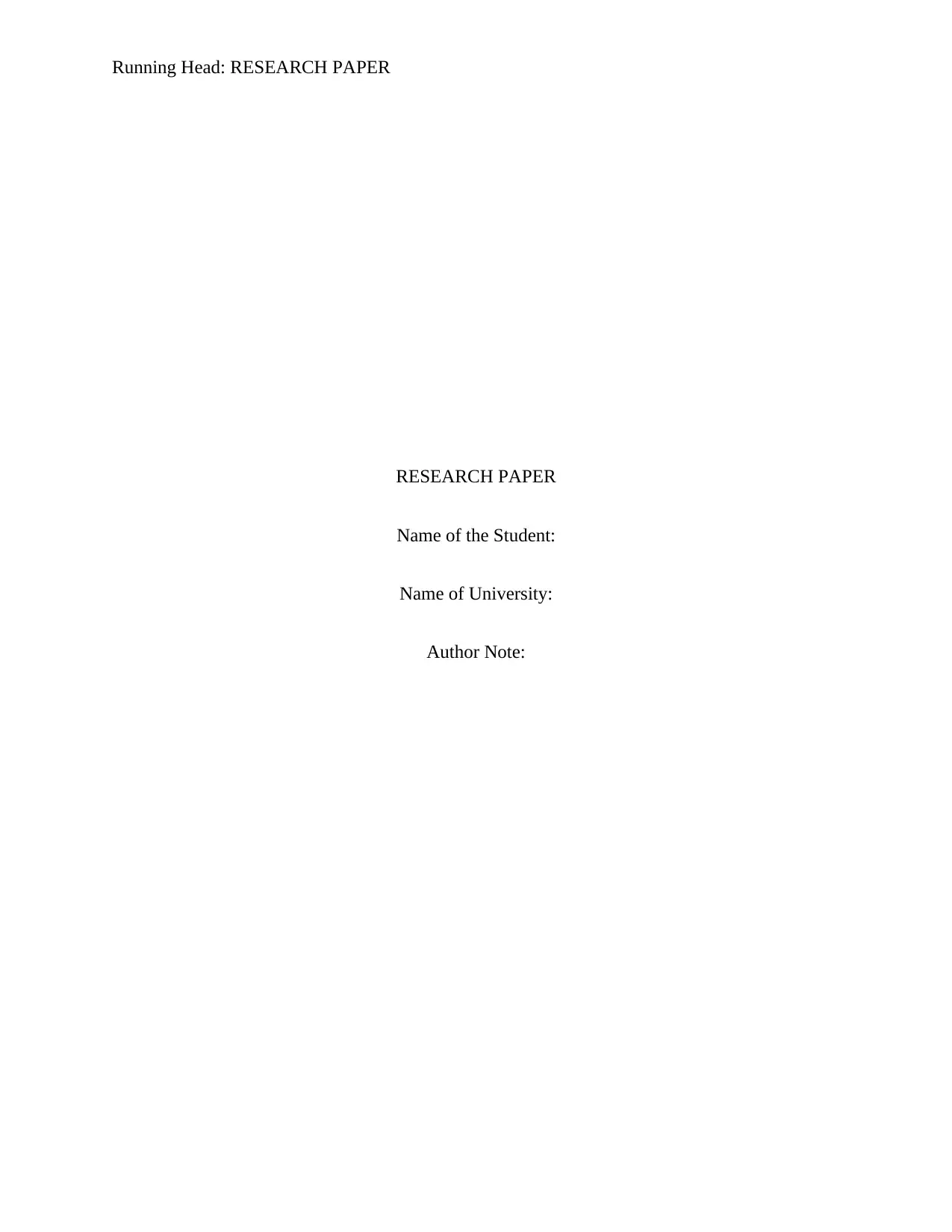
Running Head: RESEARCH PAPER
RESEARCH PAPER
Name of the Student:
Name of University:
Author Note:
RESEARCH PAPER
Name of the Student:
Name of University:
Author Note:
Paraphrase This Document
Need a fresh take? Get an instant paraphrase of this document with our AI Paraphraser
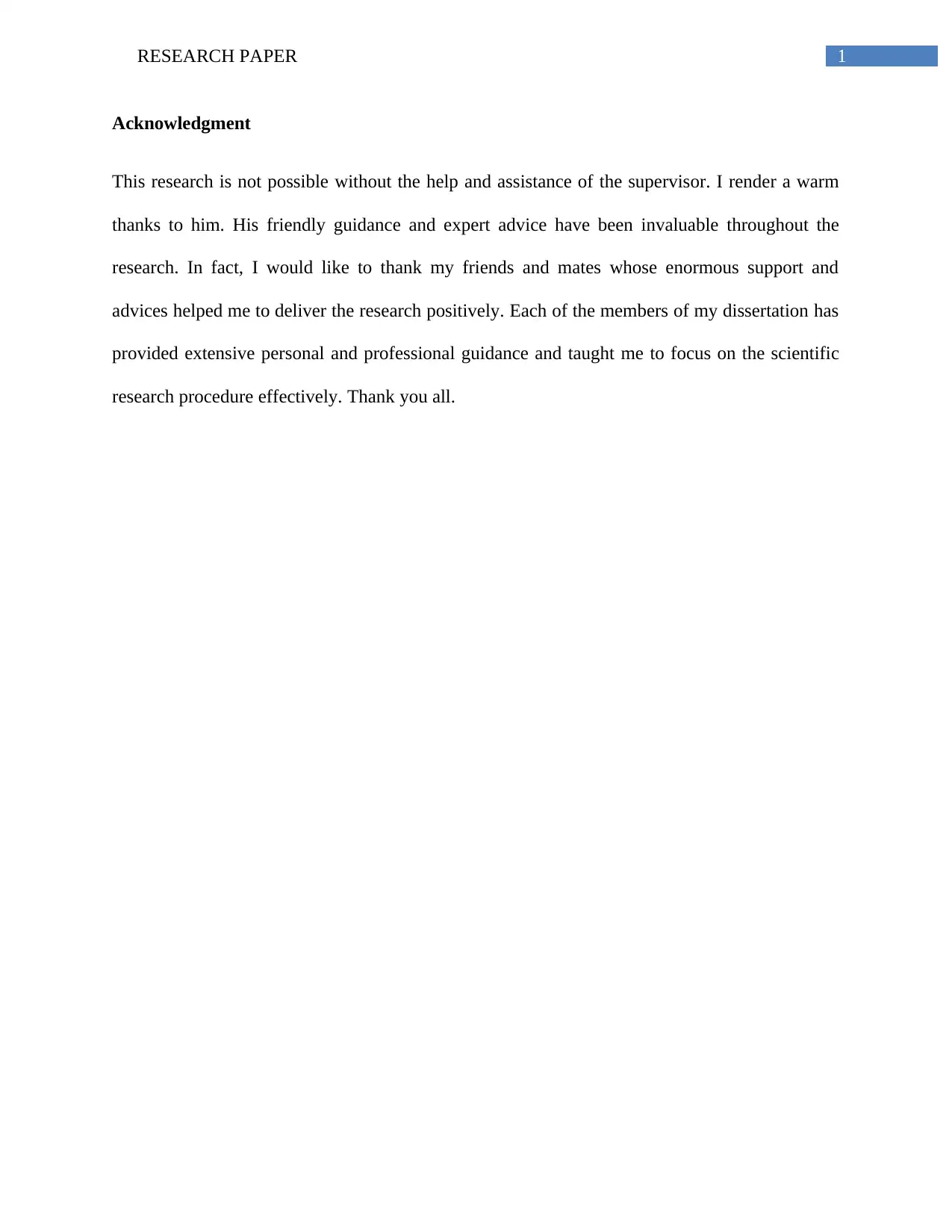
1RESEARCH PAPER
Acknowledgment
This research is not possible without the help and assistance of the supervisor. I render a warm
thanks to him. His friendly guidance and expert advice have been invaluable throughout the
research. In fact, I would like to thank my friends and mates whose enormous support and
advices helped me to deliver the research positively. Each of the members of my dissertation has
provided extensive personal and professional guidance and taught me to focus on the scientific
research procedure effectively. Thank you all.
Acknowledgment
This research is not possible without the help and assistance of the supervisor. I render a warm
thanks to him. His friendly guidance and expert advice have been invaluable throughout the
research. In fact, I would like to thank my friends and mates whose enormous support and
advices helped me to deliver the research positively. Each of the members of my dissertation has
provided extensive personal and professional guidance and taught me to focus on the scientific
research procedure effectively. Thank you all.
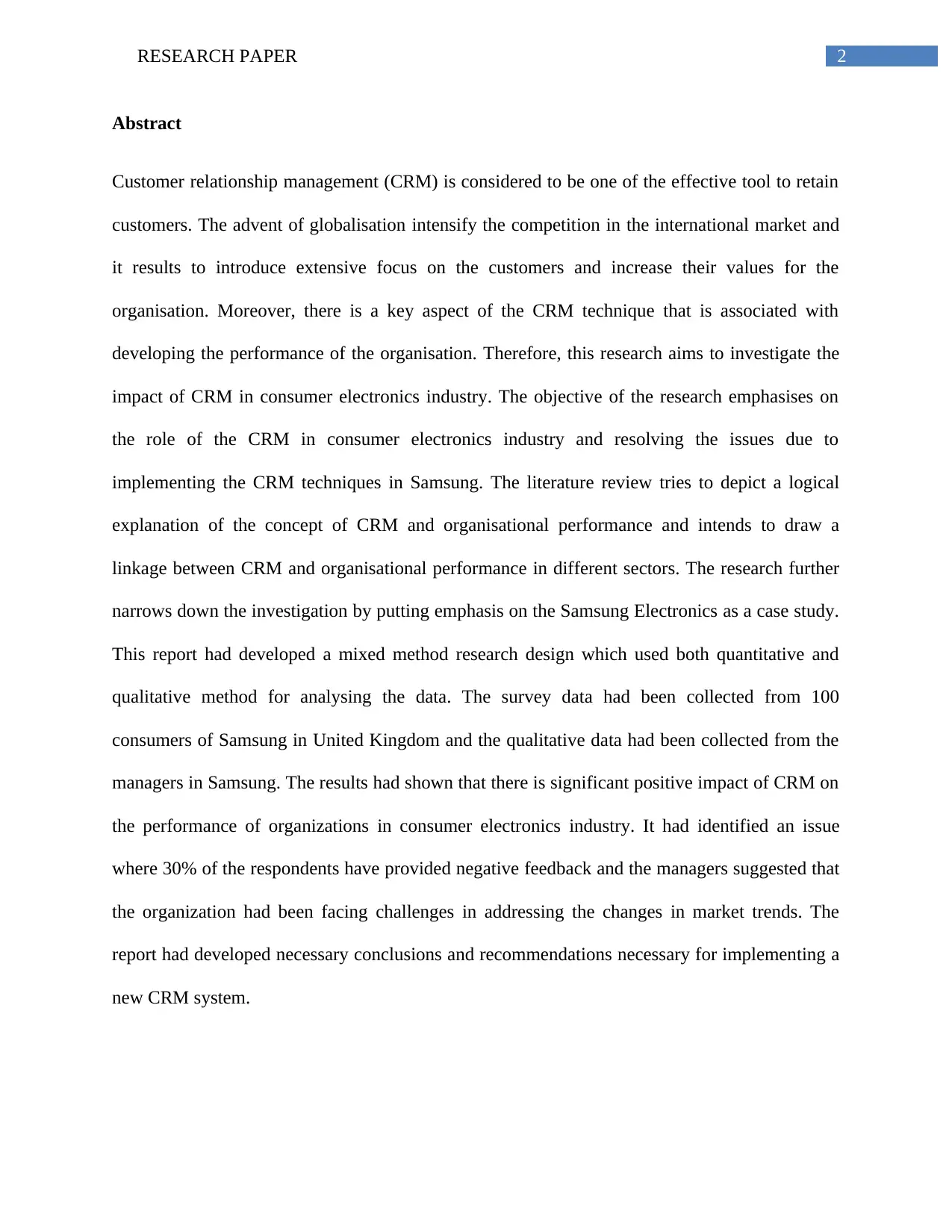
2RESEARCH PAPER
Abstract
Customer relationship management (CRM) is considered to be one of the effective tool to retain
customers. The advent of globalisation intensify the competition in the international market and
it results to introduce extensive focus on the customers and increase their values for the
organisation. Moreover, there is a key aspect of the CRM technique that is associated with
developing the performance of the organisation. Therefore, this research aims to investigate the
impact of CRM in consumer electronics industry. The objective of the research emphasises on
the role of the CRM in consumer electronics industry and resolving the issues due to
implementing the CRM techniques in Samsung. The literature review tries to depict a logical
explanation of the concept of CRM and organisational performance and intends to draw a
linkage between CRM and organisational performance in different sectors. The research further
narrows down the investigation by putting emphasis on the Samsung Electronics as a case study.
This report had developed a mixed method research design which used both quantitative and
qualitative method for analysing the data. The survey data had been collected from 100
consumers of Samsung in United Kingdom and the qualitative data had been collected from the
managers in Samsung. The results had shown that there is significant positive impact of CRM on
the performance of organizations in consumer electronics industry. It had identified an issue
where 30% of the respondents have provided negative feedback and the managers suggested that
the organization had been facing challenges in addressing the changes in market trends. The
report had developed necessary conclusions and recommendations necessary for implementing a
new CRM system.
Abstract
Customer relationship management (CRM) is considered to be one of the effective tool to retain
customers. The advent of globalisation intensify the competition in the international market and
it results to introduce extensive focus on the customers and increase their values for the
organisation. Moreover, there is a key aspect of the CRM technique that is associated with
developing the performance of the organisation. Therefore, this research aims to investigate the
impact of CRM in consumer electronics industry. The objective of the research emphasises on
the role of the CRM in consumer electronics industry and resolving the issues due to
implementing the CRM techniques in Samsung. The literature review tries to depict a logical
explanation of the concept of CRM and organisational performance and intends to draw a
linkage between CRM and organisational performance in different sectors. The research further
narrows down the investigation by putting emphasis on the Samsung Electronics as a case study.
This report had developed a mixed method research design which used both quantitative and
qualitative method for analysing the data. The survey data had been collected from 100
consumers of Samsung in United Kingdom and the qualitative data had been collected from the
managers in Samsung. The results had shown that there is significant positive impact of CRM on
the performance of organizations in consumer electronics industry. It had identified an issue
where 30% of the respondents have provided negative feedback and the managers suggested that
the organization had been facing challenges in addressing the changes in market trends. The
report had developed necessary conclusions and recommendations necessary for implementing a
new CRM system.
⊘ This is a preview!⊘
Do you want full access?
Subscribe today to unlock all pages.

Trusted by 1+ million students worldwide
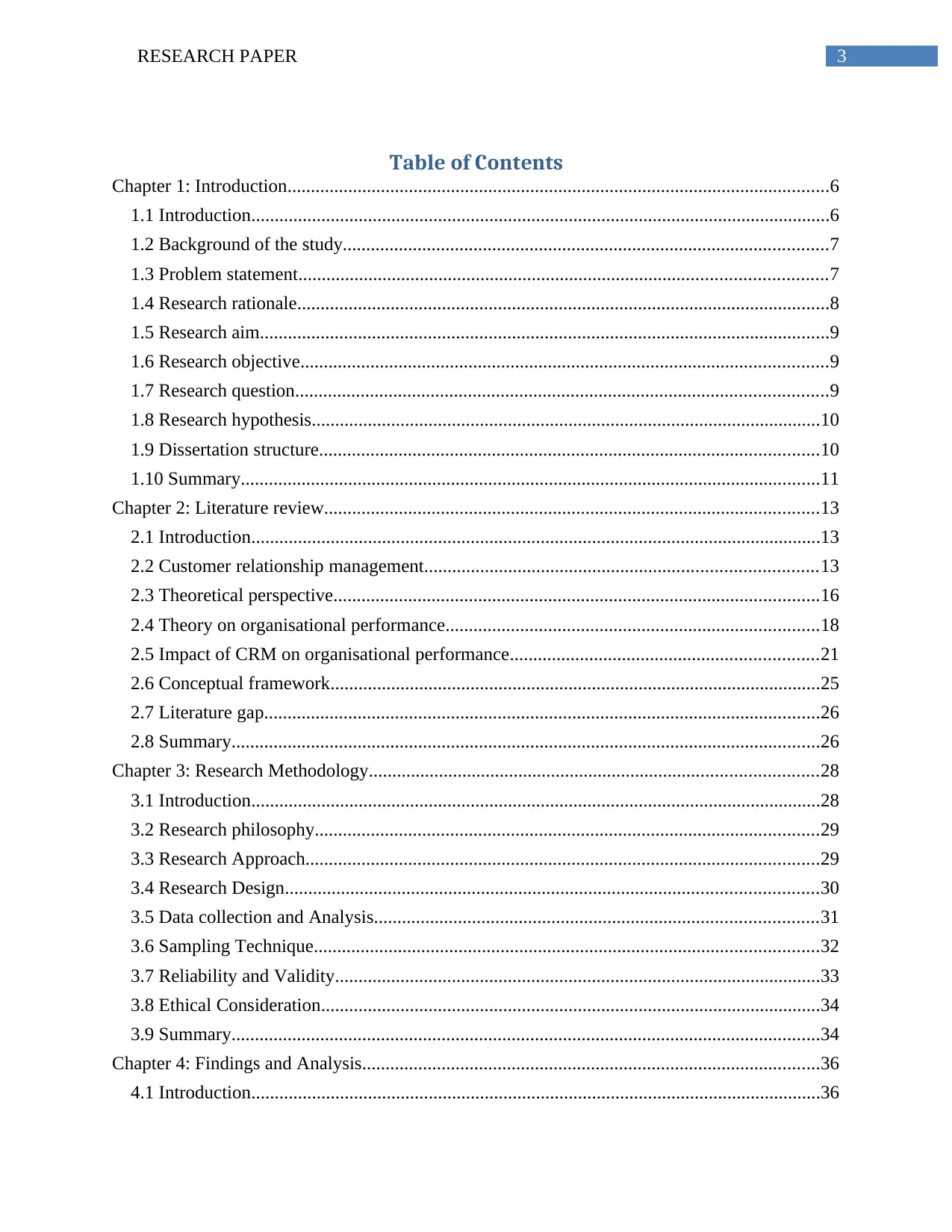
3RESEARCH PAPER
Table of Contents
Chapter 1: Introduction....................................................................................................................6
1.1 Introduction............................................................................................................................6
1.2 Background of the study........................................................................................................7
1.3 Problem statement.................................................................................................................7
1.4 Research rationale..................................................................................................................8
1.5 Research aim..........................................................................................................................9
1.6 Research objective.................................................................................................................9
1.7 Research question..................................................................................................................9
1.8 Research hypothesis.............................................................................................................10
1.9 Dissertation structure...........................................................................................................10
1.10 Summary............................................................................................................................11
Chapter 2: Literature review..........................................................................................................13
2.1 Introduction..........................................................................................................................13
2.2 Customer relationship management....................................................................................13
2.3 Theoretical perspective........................................................................................................16
2.4 Theory on organisational performance................................................................................18
2.5 Impact of CRM on organisational performance..................................................................21
2.6 Conceptual framework.........................................................................................................25
2.7 Literature gap.......................................................................................................................26
2.8 Summary..............................................................................................................................26
Chapter 3: Research Methodology................................................................................................28
3.1 Introduction..........................................................................................................................28
3.2 Research philosophy............................................................................................................29
3.3 Research Approach..............................................................................................................29
3.4 Research Design..................................................................................................................30
3.5 Data collection and Analysis...............................................................................................31
3.6 Sampling Technique............................................................................................................32
3.7 Reliability and Validity........................................................................................................33
3.8 Ethical Consideration...........................................................................................................34
3.9 Summary..............................................................................................................................34
Chapter 4: Findings and Analysis..................................................................................................36
4.1 Introduction..........................................................................................................................36
Table of Contents
Chapter 1: Introduction....................................................................................................................6
1.1 Introduction............................................................................................................................6
1.2 Background of the study........................................................................................................7
1.3 Problem statement.................................................................................................................7
1.4 Research rationale..................................................................................................................8
1.5 Research aim..........................................................................................................................9
1.6 Research objective.................................................................................................................9
1.7 Research question..................................................................................................................9
1.8 Research hypothesis.............................................................................................................10
1.9 Dissertation structure...........................................................................................................10
1.10 Summary............................................................................................................................11
Chapter 2: Literature review..........................................................................................................13
2.1 Introduction..........................................................................................................................13
2.2 Customer relationship management....................................................................................13
2.3 Theoretical perspective........................................................................................................16
2.4 Theory on organisational performance................................................................................18
2.5 Impact of CRM on organisational performance..................................................................21
2.6 Conceptual framework.........................................................................................................25
2.7 Literature gap.......................................................................................................................26
2.8 Summary..............................................................................................................................26
Chapter 3: Research Methodology................................................................................................28
3.1 Introduction..........................................................................................................................28
3.2 Research philosophy............................................................................................................29
3.3 Research Approach..............................................................................................................29
3.4 Research Design..................................................................................................................30
3.5 Data collection and Analysis...............................................................................................31
3.6 Sampling Technique............................................................................................................32
3.7 Reliability and Validity........................................................................................................33
3.8 Ethical Consideration...........................................................................................................34
3.9 Summary..............................................................................................................................34
Chapter 4: Findings and Analysis..................................................................................................36
4.1 Introduction..........................................................................................................................36
Paraphrase This Document
Need a fresh take? Get an instant paraphrase of this document with our AI Paraphraser
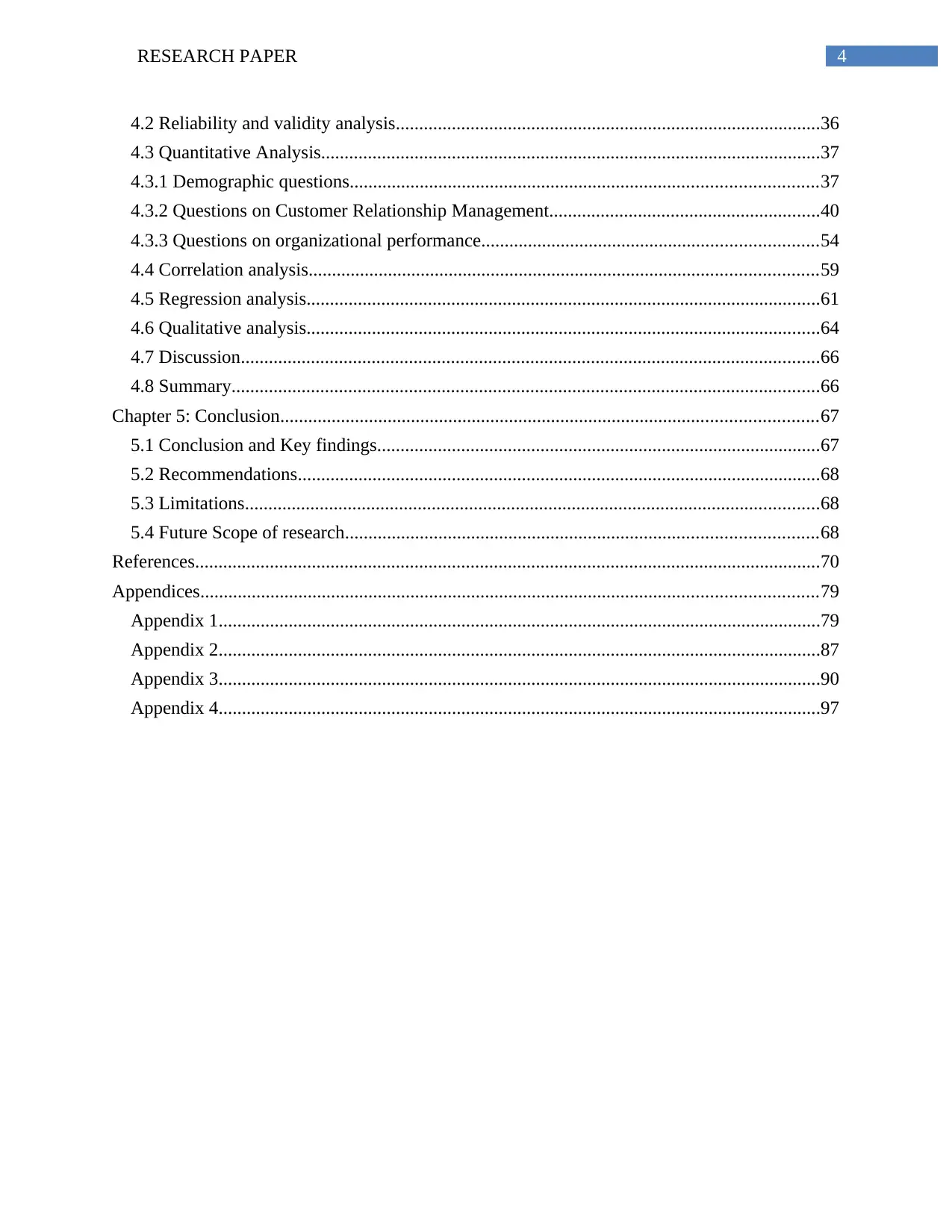
4RESEARCH PAPER
4.2 Reliability and validity analysis...........................................................................................36
4.3 Quantitative Analysis...........................................................................................................37
4.3.1 Demographic questions....................................................................................................37
4.3.2 Questions on Customer Relationship Management..........................................................40
4.3.3 Questions on organizational performance........................................................................54
4.4 Correlation analysis.............................................................................................................59
4.5 Regression analysis..............................................................................................................61
4.6 Qualitative analysis..............................................................................................................64
4.7 Discussion............................................................................................................................66
4.8 Summary..............................................................................................................................66
Chapter 5: Conclusion...................................................................................................................67
5.1 Conclusion and Key findings...............................................................................................67
5.2 Recommendations................................................................................................................68
5.3 Limitations...........................................................................................................................68
5.4 Future Scope of research.....................................................................................................68
References......................................................................................................................................70
Appendices....................................................................................................................................79
Appendix 1.................................................................................................................................79
Appendix 2.................................................................................................................................87
Appendix 3.................................................................................................................................90
Appendix 4.................................................................................................................................97
4.2 Reliability and validity analysis...........................................................................................36
4.3 Quantitative Analysis...........................................................................................................37
4.3.1 Demographic questions....................................................................................................37
4.3.2 Questions on Customer Relationship Management..........................................................40
4.3.3 Questions on organizational performance........................................................................54
4.4 Correlation analysis.............................................................................................................59
4.5 Regression analysis..............................................................................................................61
4.6 Qualitative analysis..............................................................................................................64
4.7 Discussion............................................................................................................................66
4.8 Summary..............................................................................................................................66
Chapter 5: Conclusion...................................................................................................................67
5.1 Conclusion and Key findings...............................................................................................67
5.2 Recommendations................................................................................................................68
5.3 Limitations...........................................................................................................................68
5.4 Future Scope of research.....................................................................................................68
References......................................................................................................................................70
Appendices....................................................................................................................................79
Appendix 1.................................................................................................................................79
Appendix 2.................................................................................................................................87
Appendix 3.................................................................................................................................90
Appendix 4.................................................................................................................................97
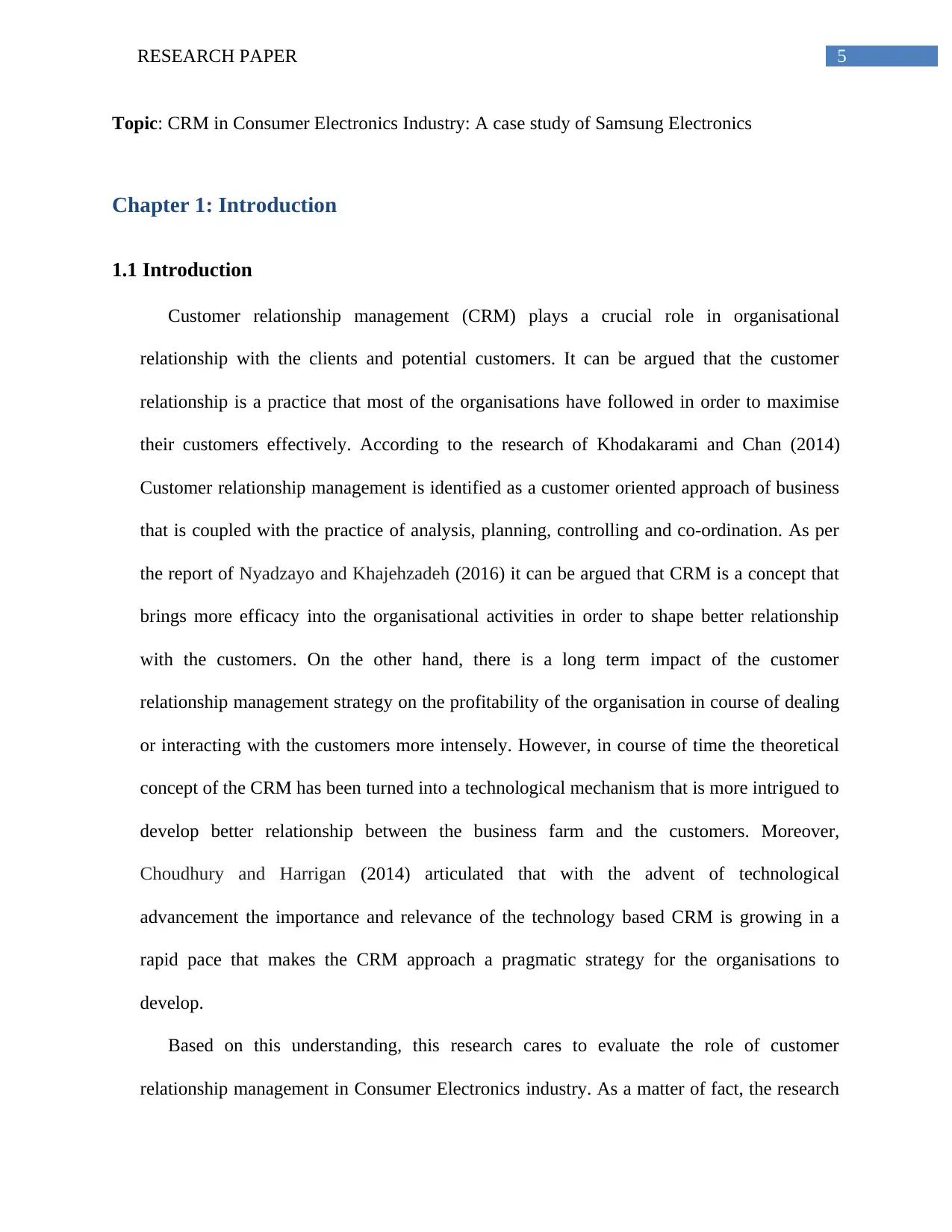
5RESEARCH PAPER
Topic: CRM in Consumer Electronics Industry: A case study of Samsung Electronics
Chapter 1: Introduction
1.1 Introduction
Customer relationship management (CRM) plays a crucial role in organisational
relationship with the clients and potential customers. It can be argued that the customer
relationship is a practice that most of the organisations have followed in order to maximise
their customers effectively. According to the research of Khodakarami and Chan (2014)
Customer relationship management is identified as a customer oriented approach of business
that is coupled with the practice of analysis, planning, controlling and co-ordination. As per
the report of Nyadzayo and Khajehzadeh (2016) it can be argued that CRM is a concept that
brings more efficacy into the organisational activities in order to shape better relationship
with the customers. On the other hand, there is a long term impact of the customer
relationship management strategy on the profitability of the organisation in course of dealing
or interacting with the customers more intensely. However, in course of time the theoretical
concept of the CRM has been turned into a technological mechanism that is more intrigued to
develop better relationship between the business farm and the customers. Moreover,
Choudhury and Harrigan (2014) articulated that with the advent of technological
advancement the importance and relevance of the technology based CRM is growing in a
rapid pace that makes the CRM approach a pragmatic strategy for the organisations to
develop.
Based on this understanding, this research cares to evaluate the role of customer
relationship management in Consumer Electronics industry. As a matter of fact, the research
Topic: CRM in Consumer Electronics Industry: A case study of Samsung Electronics
Chapter 1: Introduction
1.1 Introduction
Customer relationship management (CRM) plays a crucial role in organisational
relationship with the clients and potential customers. It can be argued that the customer
relationship is a practice that most of the organisations have followed in order to maximise
their customers effectively. According to the research of Khodakarami and Chan (2014)
Customer relationship management is identified as a customer oriented approach of business
that is coupled with the practice of analysis, planning, controlling and co-ordination. As per
the report of Nyadzayo and Khajehzadeh (2016) it can be argued that CRM is a concept that
brings more efficacy into the organisational activities in order to shape better relationship
with the customers. On the other hand, there is a long term impact of the customer
relationship management strategy on the profitability of the organisation in course of dealing
or interacting with the customers more intensely. However, in course of time the theoretical
concept of the CRM has been turned into a technological mechanism that is more intrigued to
develop better relationship between the business farm and the customers. Moreover,
Choudhury and Harrigan (2014) articulated that with the advent of technological
advancement the importance and relevance of the technology based CRM is growing in a
rapid pace that makes the CRM approach a pragmatic strategy for the organisations to
develop.
Based on this understanding, this research cares to evaluate the role of customer
relationship management in Consumer Electronics industry. As a matter of fact, the research
⊘ This is a preview!⊘
Do you want full access?
Subscribe today to unlock all pages.

Trusted by 1+ million students worldwide
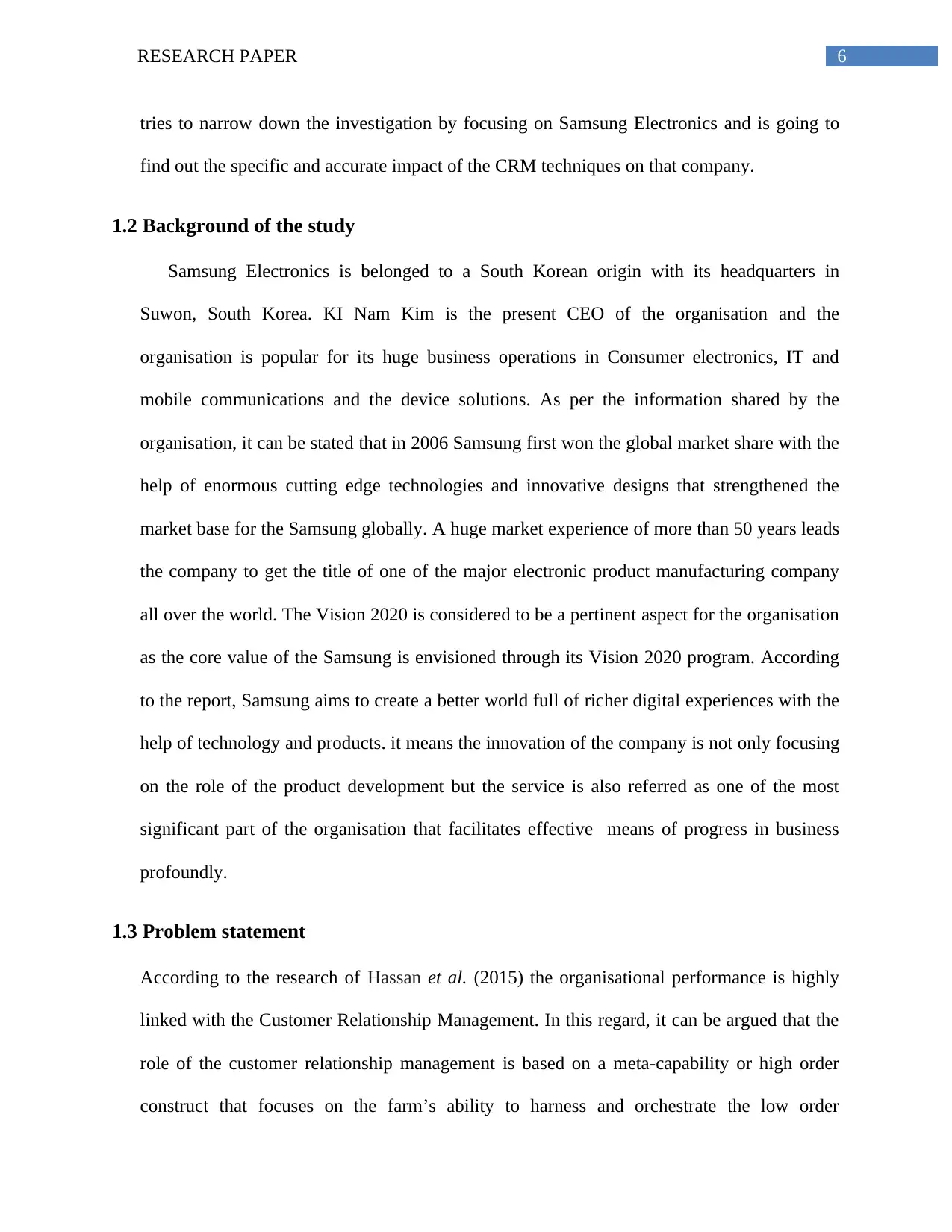
6RESEARCH PAPER
tries to narrow down the investigation by focusing on Samsung Electronics and is going to
find out the specific and accurate impact of the CRM techniques on that company.
1.2 Background of the study
Samsung Electronics is belonged to a South Korean origin with its headquarters in
Suwon, South Korea. KI Nam Kim is the present CEO of the organisation and the
organisation is popular for its huge business operations in Consumer electronics, IT and
mobile communications and the device solutions. As per the information shared by the
organisation, it can be stated that in 2006 Samsung first won the global market share with the
help of enormous cutting edge technologies and innovative designs that strengthened the
market base for the Samsung globally. A huge market experience of more than 50 years leads
the company to get the title of one of the major electronic product manufacturing company
all over the world. The Vision 2020 is considered to be a pertinent aspect for the organisation
as the core value of the Samsung is envisioned through its Vision 2020 program. According
to the report, Samsung aims to create a better world full of richer digital experiences with the
help of technology and products. it means the innovation of the company is not only focusing
on the role of the product development but the service is also referred as one of the most
significant part of the organisation that facilitates effective means of progress in business
profoundly.
1.3 Problem statement
According to the research of Hassan et al. (2015) the organisational performance is highly
linked with the Customer Relationship Management. In this regard, it can be argued that the
role of the customer relationship management is based on a meta-capability or high order
construct that focuses on the farm’s ability to harness and orchestrate the low order
tries to narrow down the investigation by focusing on Samsung Electronics and is going to
find out the specific and accurate impact of the CRM techniques on that company.
1.2 Background of the study
Samsung Electronics is belonged to a South Korean origin with its headquarters in
Suwon, South Korea. KI Nam Kim is the present CEO of the organisation and the
organisation is popular for its huge business operations in Consumer electronics, IT and
mobile communications and the device solutions. As per the information shared by the
organisation, it can be stated that in 2006 Samsung first won the global market share with the
help of enormous cutting edge technologies and innovative designs that strengthened the
market base for the Samsung globally. A huge market experience of more than 50 years leads
the company to get the title of one of the major electronic product manufacturing company
all over the world. The Vision 2020 is considered to be a pertinent aspect for the organisation
as the core value of the Samsung is envisioned through its Vision 2020 program. According
to the report, Samsung aims to create a better world full of richer digital experiences with the
help of technology and products. it means the innovation of the company is not only focusing
on the role of the product development but the service is also referred as one of the most
significant part of the organisation that facilitates effective means of progress in business
profoundly.
1.3 Problem statement
According to the research of Hassan et al. (2015) the organisational performance is highly
linked with the Customer Relationship Management. In this regard, it can be argued that the
role of the customer relationship management is based on a meta-capability or high order
construct that focuses on the farm’s ability to harness and orchestrate the low order
Paraphrase This Document
Need a fresh take? Get an instant paraphrase of this document with our AI Paraphraser
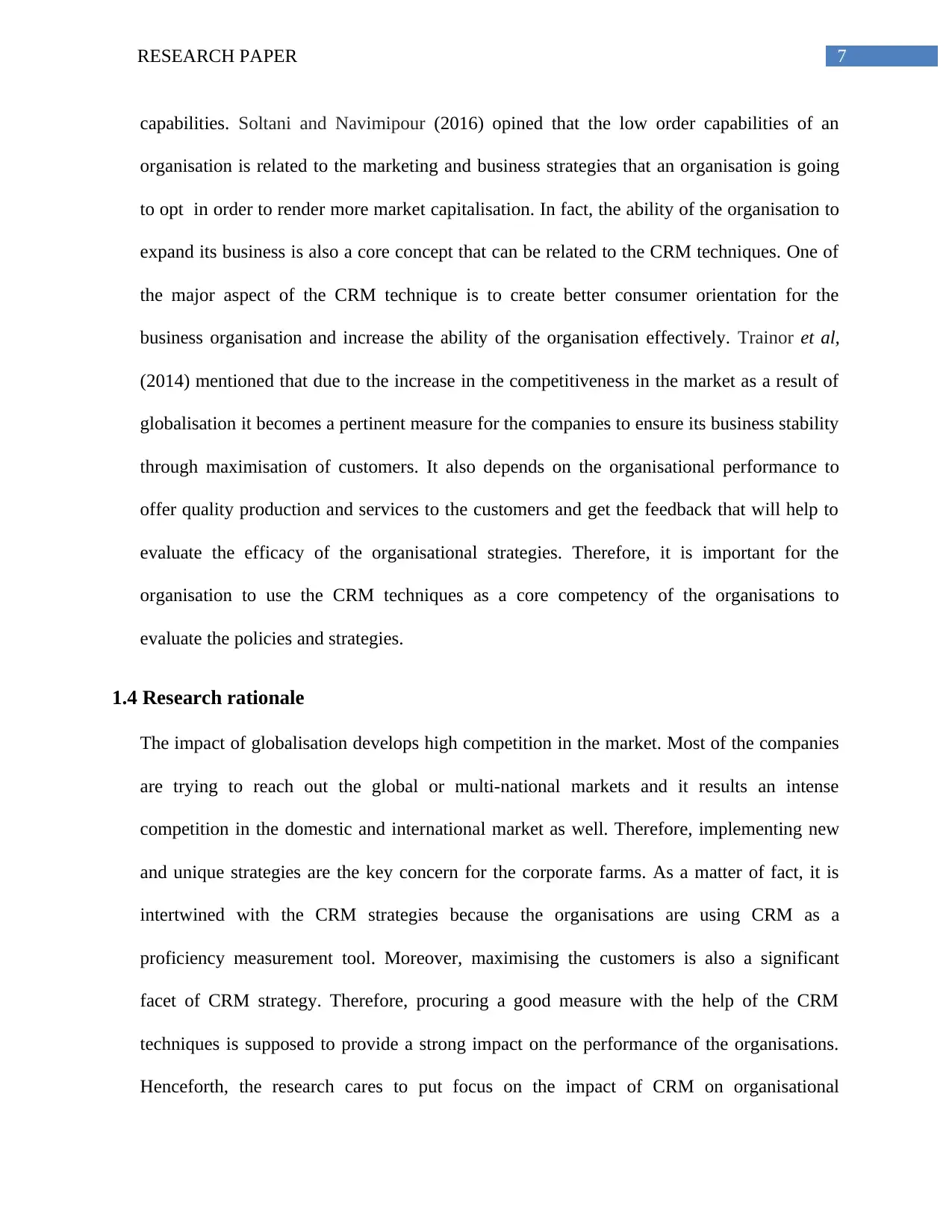
7RESEARCH PAPER
capabilities. Soltani and Navimipour (2016) opined that the low order capabilities of an
organisation is related to the marketing and business strategies that an organisation is going
to opt in order to render more market capitalisation. In fact, the ability of the organisation to
expand its business is also a core concept that can be related to the CRM techniques. One of
the major aspect of the CRM technique is to create better consumer orientation for the
business organisation and increase the ability of the organisation effectively. Trainor et al,
(2014) mentioned that due to the increase in the competitiveness in the market as a result of
globalisation it becomes a pertinent measure for the companies to ensure its business stability
through maximisation of customers. It also depends on the organisational performance to
offer quality production and services to the customers and get the feedback that will help to
evaluate the efficacy of the organisational strategies. Therefore, it is important for the
organisation to use the CRM techniques as a core competency of the organisations to
evaluate the policies and strategies.
1.4 Research rationale
The impact of globalisation develops high competition in the market. Most of the companies
are trying to reach out the global or multi-national markets and it results an intense
competition in the domestic and international market as well. Therefore, implementing new
and unique strategies are the key concern for the corporate farms. As a matter of fact, it is
intertwined with the CRM strategies because the organisations are using CRM as a
proficiency measurement tool. Moreover, maximising the customers is also a significant
facet of CRM strategy. Therefore, procuring a good measure with the help of the CRM
techniques is supposed to provide a strong impact on the performance of the organisations.
Henceforth, the research cares to put focus on the impact of CRM on organisational
capabilities. Soltani and Navimipour (2016) opined that the low order capabilities of an
organisation is related to the marketing and business strategies that an organisation is going
to opt in order to render more market capitalisation. In fact, the ability of the organisation to
expand its business is also a core concept that can be related to the CRM techniques. One of
the major aspect of the CRM technique is to create better consumer orientation for the
business organisation and increase the ability of the organisation effectively. Trainor et al,
(2014) mentioned that due to the increase in the competitiveness in the market as a result of
globalisation it becomes a pertinent measure for the companies to ensure its business stability
through maximisation of customers. It also depends on the organisational performance to
offer quality production and services to the customers and get the feedback that will help to
evaluate the efficacy of the organisational strategies. Therefore, it is important for the
organisation to use the CRM techniques as a core competency of the organisations to
evaluate the policies and strategies.
1.4 Research rationale
The impact of globalisation develops high competition in the market. Most of the companies
are trying to reach out the global or multi-national markets and it results an intense
competition in the domestic and international market as well. Therefore, implementing new
and unique strategies are the key concern for the corporate farms. As a matter of fact, it is
intertwined with the CRM strategies because the organisations are using CRM as a
proficiency measurement tool. Moreover, maximising the customers is also a significant
facet of CRM strategy. Therefore, procuring a good measure with the help of the CRM
techniques is supposed to provide a strong impact on the performance of the organisations.
Henceforth, the research cares to put focus on the impact of CRM on organisational
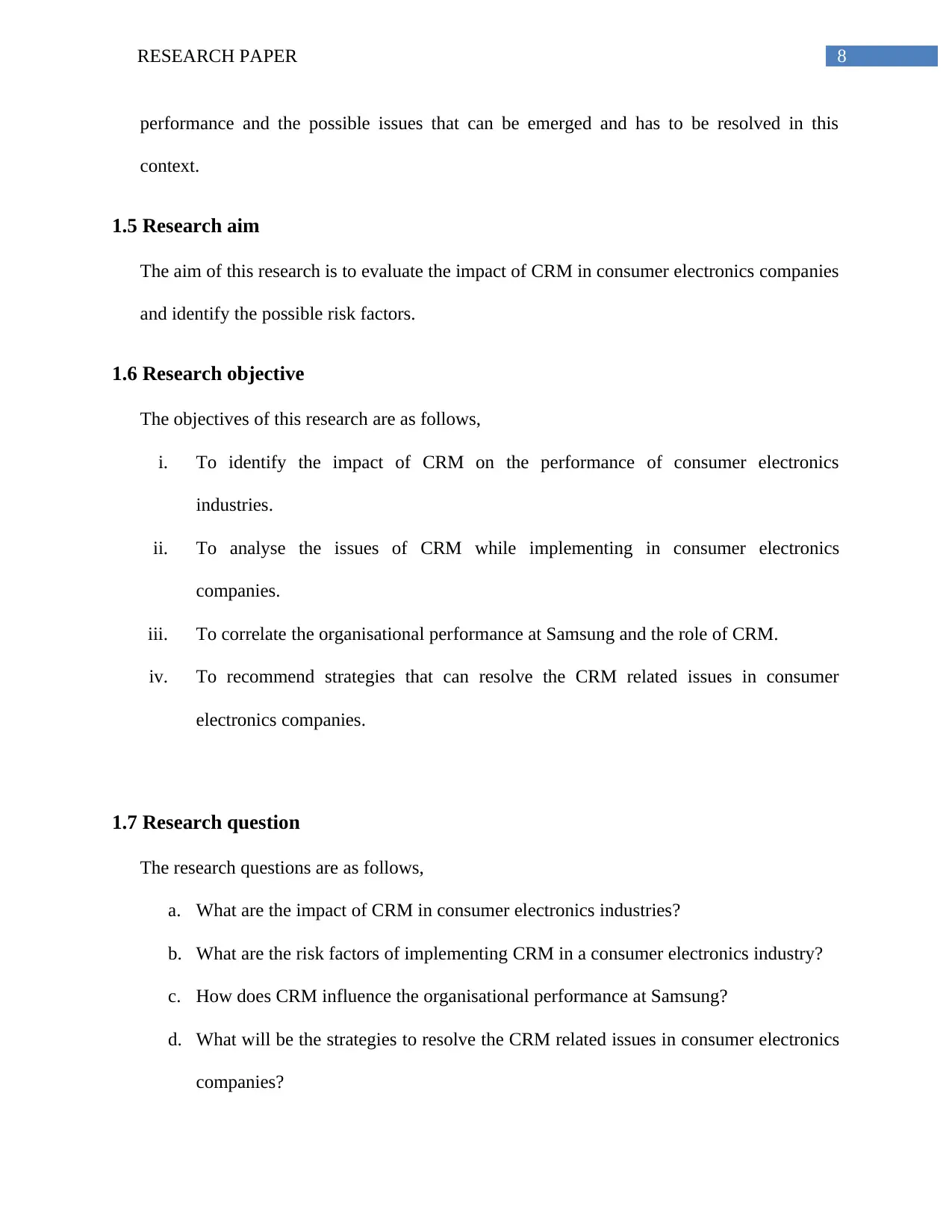
8RESEARCH PAPER
performance and the possible issues that can be emerged and has to be resolved in this
context.
1.5 Research aim
The aim of this research is to evaluate the impact of CRM in consumer electronics companies
and identify the possible risk factors.
1.6 Research objective
The objectives of this research are as follows,
i. To identify the impact of CRM on the performance of consumer electronics
industries.
ii. To analyse the issues of CRM while implementing in consumer electronics
companies.
iii. To correlate the organisational performance at Samsung and the role of CRM.
iv. To recommend strategies that can resolve the CRM related issues in consumer
electronics companies.
1.7 Research question
The research questions are as follows,
a. What are the impact of CRM in consumer electronics industries?
b. What are the risk factors of implementing CRM in a consumer electronics industry?
c. How does CRM influence the organisational performance at Samsung?
d. What will be the strategies to resolve the CRM related issues in consumer electronics
companies?
performance and the possible issues that can be emerged and has to be resolved in this
context.
1.5 Research aim
The aim of this research is to evaluate the impact of CRM in consumer electronics companies
and identify the possible risk factors.
1.6 Research objective
The objectives of this research are as follows,
i. To identify the impact of CRM on the performance of consumer electronics
industries.
ii. To analyse the issues of CRM while implementing in consumer electronics
companies.
iii. To correlate the organisational performance at Samsung and the role of CRM.
iv. To recommend strategies that can resolve the CRM related issues in consumer
electronics companies.
1.7 Research question
The research questions are as follows,
a. What are the impact of CRM in consumer electronics industries?
b. What are the risk factors of implementing CRM in a consumer electronics industry?
c. How does CRM influence the organisational performance at Samsung?
d. What will be the strategies to resolve the CRM related issues in consumer electronics
companies?
⊘ This is a preview!⊘
Do you want full access?
Subscribe today to unlock all pages.

Trusted by 1+ million students worldwide
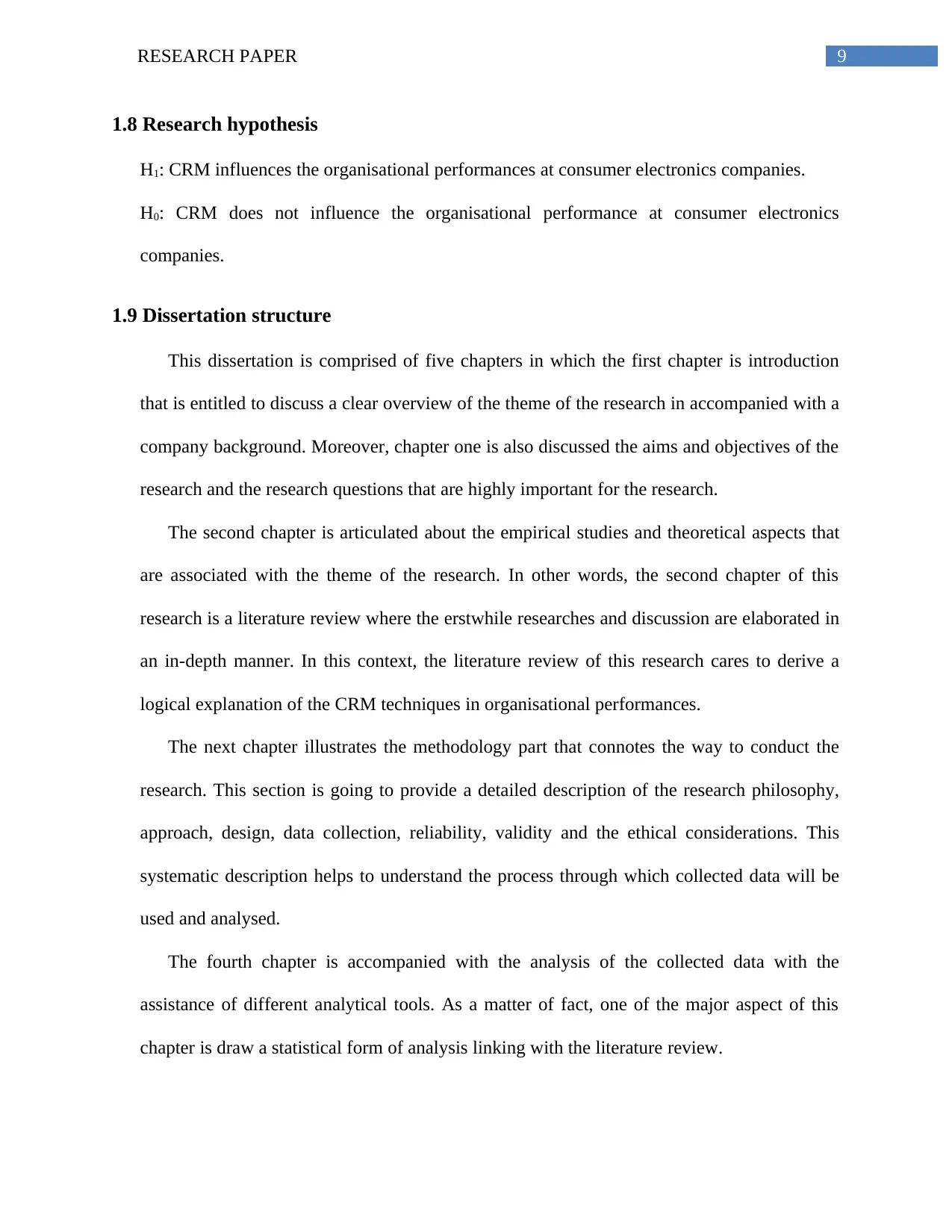
9RESEARCH PAPER
1.8 Research hypothesis
H1: CRM influences the organisational performances at consumer electronics companies.
H0: CRM does not influence the organisational performance at consumer electronics
companies.
1.9 Dissertation structure
This dissertation is comprised of five chapters in which the first chapter is introduction
that is entitled to discuss a clear overview of the theme of the research in accompanied with a
company background. Moreover, chapter one is also discussed the aims and objectives of the
research and the research questions that are highly important for the research.
The second chapter is articulated about the empirical studies and theoretical aspects that
are associated with the theme of the research. In other words, the second chapter of this
research is a literature review where the erstwhile researches and discussion are elaborated in
an in-depth manner. In this context, the literature review of this research cares to derive a
logical explanation of the CRM techniques in organisational performances.
The next chapter illustrates the methodology part that connotes the way to conduct the
research. This section is going to provide a detailed description of the research philosophy,
approach, design, data collection, reliability, validity and the ethical considerations. This
systematic description helps to understand the process through which collected data will be
used and analysed.
The fourth chapter is accompanied with the analysis of the collected data with the
assistance of different analytical tools. As a matter of fact, one of the major aspect of this
chapter is draw a statistical form of analysis linking with the literature review.
1.8 Research hypothesis
H1: CRM influences the organisational performances at consumer electronics companies.
H0: CRM does not influence the organisational performance at consumer electronics
companies.
1.9 Dissertation structure
This dissertation is comprised of five chapters in which the first chapter is introduction
that is entitled to discuss a clear overview of the theme of the research in accompanied with a
company background. Moreover, chapter one is also discussed the aims and objectives of the
research and the research questions that are highly important for the research.
The second chapter is articulated about the empirical studies and theoretical aspects that
are associated with the theme of the research. In other words, the second chapter of this
research is a literature review where the erstwhile researches and discussion are elaborated in
an in-depth manner. In this context, the literature review of this research cares to derive a
logical explanation of the CRM techniques in organisational performances.
The next chapter illustrates the methodology part that connotes the way to conduct the
research. This section is going to provide a detailed description of the research philosophy,
approach, design, data collection, reliability, validity and the ethical considerations. This
systematic description helps to understand the process through which collected data will be
used and analysed.
The fourth chapter is accompanied with the analysis of the collected data with the
assistance of different analytical tools. As a matter of fact, one of the major aspect of this
chapter is draw a statistical form of analysis linking with the literature review.
Paraphrase This Document
Need a fresh take? Get an instant paraphrase of this document with our AI Paraphraser
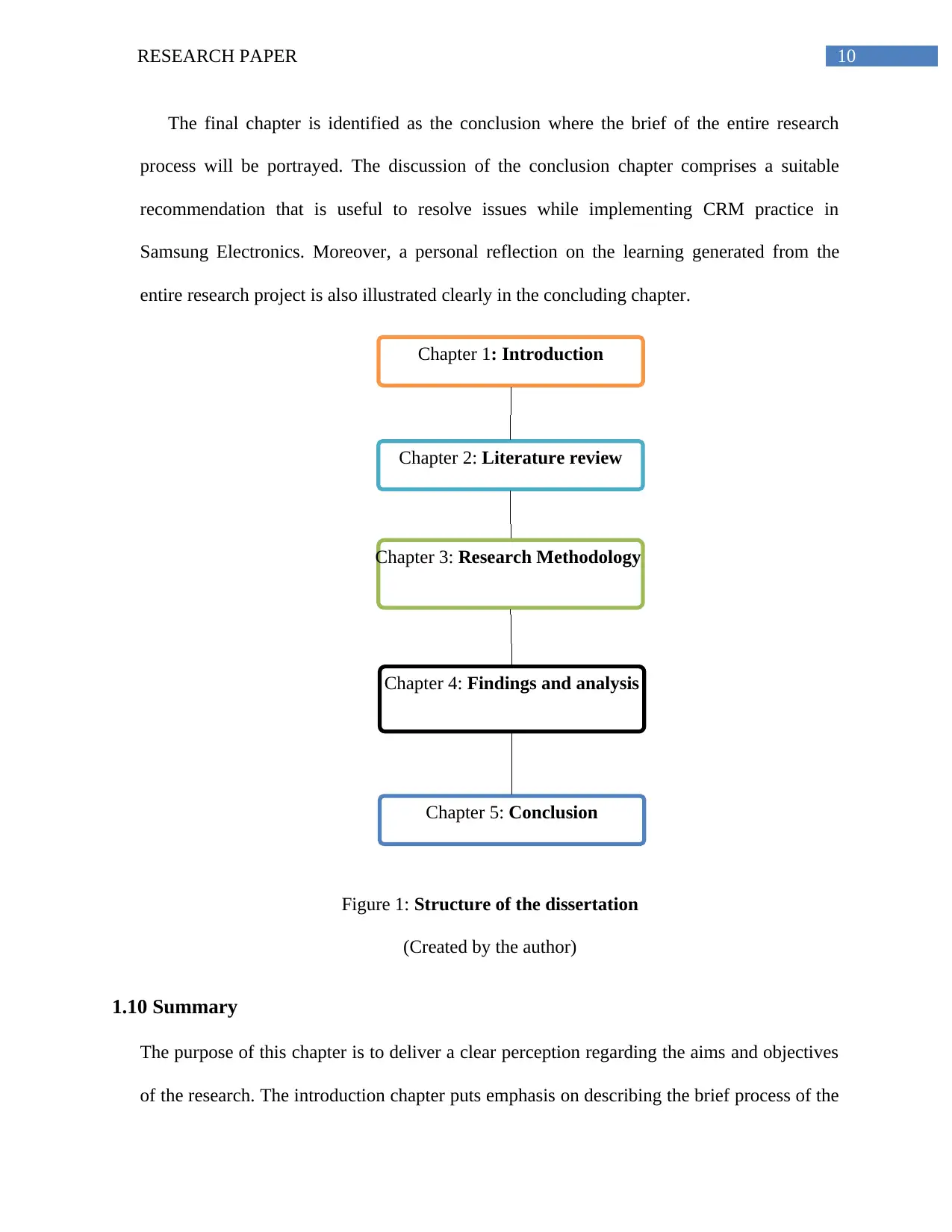
Chapter 1: Introduction
Chapter 2: Literature review
Chapter 3: Research Methodology
Chapter 4: Findings and analysis
Chapter 5: Conclusion
10RESEARCH PAPER
The final chapter is identified as the conclusion where the brief of the entire research
process will be portrayed. The discussion of the conclusion chapter comprises a suitable
recommendation that is useful to resolve issues while implementing CRM practice in
Samsung Electronics. Moreover, a personal reflection on the learning generated from the
entire research project is also illustrated clearly in the concluding chapter.
Figure 1: Structure of the dissertation
(Created by the author)
1.10 Summary
The purpose of this chapter is to deliver a clear perception regarding the aims and objectives
of the research. The introduction chapter puts emphasis on describing the brief process of the
Chapter 2: Literature review
Chapter 3: Research Methodology
Chapter 4: Findings and analysis
Chapter 5: Conclusion
10RESEARCH PAPER
The final chapter is identified as the conclusion where the brief of the entire research
process will be portrayed. The discussion of the conclusion chapter comprises a suitable
recommendation that is useful to resolve issues while implementing CRM practice in
Samsung Electronics. Moreover, a personal reflection on the learning generated from the
entire research project is also illustrated clearly in the concluding chapter.
Figure 1: Structure of the dissertation
(Created by the author)
1.10 Summary
The purpose of this chapter is to deliver a clear perception regarding the aims and objectives
of the research. The introduction chapter puts emphasis on describing the brief process of the
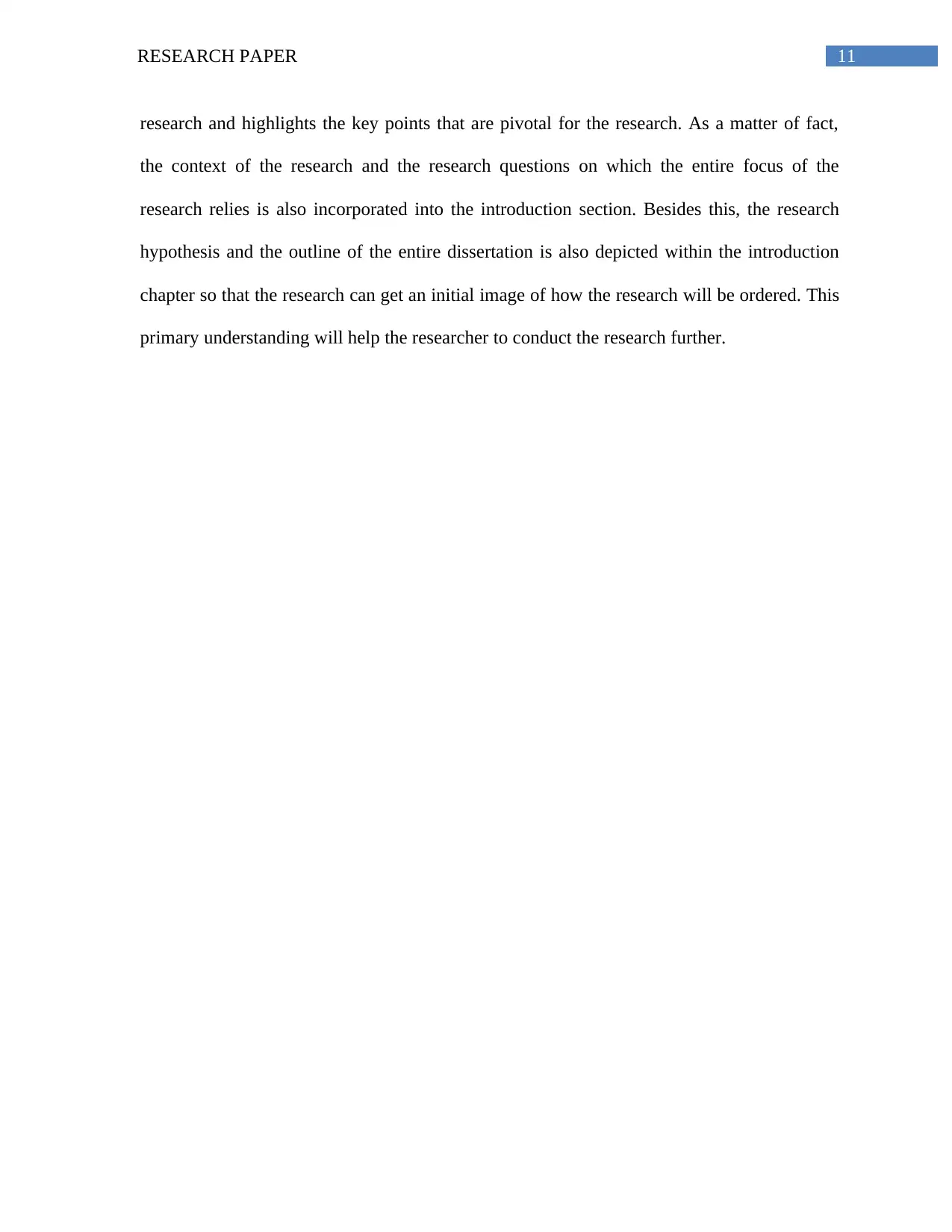
11RESEARCH PAPER
research and highlights the key points that are pivotal for the research. As a matter of fact,
the context of the research and the research questions on which the entire focus of the
research relies is also incorporated into the introduction section. Besides this, the research
hypothesis and the outline of the entire dissertation is also depicted within the introduction
chapter so that the research can get an initial image of how the research will be ordered. This
primary understanding will help the researcher to conduct the research further.
research and highlights the key points that are pivotal for the research. As a matter of fact,
the context of the research and the research questions on which the entire focus of the
research relies is also incorporated into the introduction section. Besides this, the research
hypothesis and the outline of the entire dissertation is also depicted within the introduction
chapter so that the research can get an initial image of how the research will be ordered. This
primary understanding will help the researcher to conduct the research further.
⊘ This is a preview!⊘
Do you want full access?
Subscribe today to unlock all pages.

Trusted by 1+ million students worldwide
1 out of 100
Related Documents
Your All-in-One AI-Powered Toolkit for Academic Success.
+13062052269
info@desklib.com
Available 24*7 on WhatsApp / Email
![[object Object]](/_next/static/media/star-bottom.7253800d.svg)
Unlock your academic potential
Copyright © 2020–2025 A2Z Services. All Rights Reserved. Developed and managed by ZUCOL.





